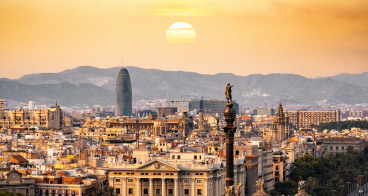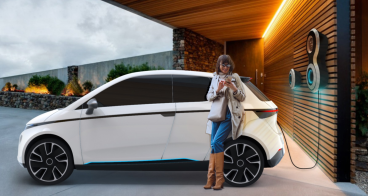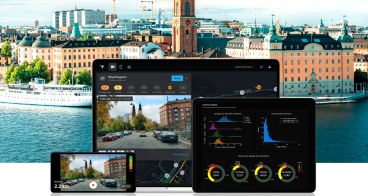Towards cleaner and more energy-efficient mobility
As the EU takes further measures in its aspiration to reach climate neutrality, the role of cities and urban environments grows increasingly evident. With 65% of total EU energy consumption and 70% of greenhouse gas emissions occurring in urban areas, their transformation is crucial to hitting the Green Deal 2030 targets.
The European Commission has recently announced the 100 cities that will take part in the Cities Mission: Reaching climate neutrality by 2030. These will have a major contribution to the EU’s efforts in building a green and sustainable future. They will also serve as lighthouses for other EU cities to learn from their experiences as mission-led municipalities. With 75% of EU citizens residing in urban environments, they will be significantly impacted by the cities’ transition to a climate-neutral reality.
Urban transport causes a third of city emissions. Reducing emissions by implementing more energy-efficient solutions is therefore one of the key needs of EU cities and their citizens that will evolve in the efforts towards sustainability. Indeed, this evolution has already begun, with one of the biggest transformations in mobility over the past decades - the transition from combustion - driven transport to electric mobility. This has unlocked the ability to decrease and even eliminate vehicle reliance on fossil fuels, the single most polluting element in transportation. New, renewable energy options are now arising for the mobility sector, spanning from wind and solar energies to hydrogen and biogas. However, these do not come without a shortage of challenges.
Charging infrastructure
In order to advance the transition to renewable sources of energy, the supply infrastructure first needs to be incorporated into urban and interurban areas. The involved stakeholders are encountering issues such as predicting the levels of demand for the different types of energy and building the grid infrastructure accordingly.
Evio has created a suitable solution for this situation: a Software-as-a-Service platform for the EV charging ecosystem. By leveraging the data acquired from users and providers, they facilitate a series of services to both the offer and demand side. Their beneficiaries range from the EV user to the EV fleet and infrastructure managers. This includes a decision-support system for providers of charging infrastructure, and a management tool to optimise existing operations. It also provides services for private owners of electric chargers, including monetisation of their infrastructure. By facilitating these varied services, Evio removes the existing entry barriers and satisfies the current demand levels which are not yet met by the market.
The transition of public transport services to sustainable energy comes with its own challenges. As further cities and public transport authorities implement this change, they need new solutions to address them. This was the case for the city of Barcelona in their goal to electrify their public bus transport. As their fleet grew, the authorities were confronted with an increase in the power grid to charge the buses. Moreover, the high demand for simultaneously connected charging points was overloading the network.
The charging solution developed by Bia was able to solve these issues for Barcelona's electric bus fleet. Their solution facilitates the integration of recharging points in electric installations. It also promotes the use of renewables by aggregating demand and tailoring it to supply to avoid oversaturation, which prevents the need to use non-renewable energy for the overloads. This also avoids the incurred cost overruns.
Bia Power addressed the lack of information of peak loads by generating future curves based on TMB’s real charging data. This enables the prediction of the usage and avoiding the mentioned oversaturation. With Bia’s support, a subset of chargers from one of the TMB depots (with up to 30 e-buses) has also been equipped with an optimised EV charging platform.
As seen, charging infrastructure is sine qua non for a fossil-free future. As well as the existing infrastructure, there is the opportunity to develop new, innovative solutions. The Swedish company Elonroad is leading by example: The start-up has developed a road recharging model to allow vehicles to wirelessly recharge while on the move. This intelligent recharging system is implemented on existing or new roads, and can also be used at parking spaces for wireless, stationary recharging.
The system unlocks the opportunity to keep battery size small in electric vehicles, as the need for extensive storage is removed. It is also equipped with software that can measure the amount of energy required for each vehicle, which can be used to elaborate individual billing plans and simplify this process.
The benefits for micromobility
In the urban environment, existing and new micromobility transport modes must also be directed at promoting sustainable mobility. This includes both private and shared modes of vehicles that are used for short commutes and are common alternatives to cars and public transport.
Motorcycles are a well-established mode of private transportation in many European cities given they are easy to operate, agile and much easier to park. Fortunately, in recent years we have seen an uprising of several shared motorcycle services growing steadily. There has also been an uprising of shared electric motorcycle services, making it easier to enjoy the freedom of such a vehicle while being more sustainable. Several shared services also include a variety of additional mobility options such as bikes, e-bikes and e-scooters. These services are available for citizens, corporations, and more.
Wyze Mobility is a clear example of this shift towards sustainable shared e-mobility. The Portuguese company offers different electric vehicles, from bikes to electric scooters, which cover the diverse mobility needs of urban citizens, from short to long commutes, and from short, one-time uses to spanning a series of days. They also provide services for corporations to have access to a zero-carbon fleet to use for daily commuting.
On another note, since electric kick scooters emerged, two main concerns have arisen: Where to charge and, most urgently, where to properly park them. The Trap docking station addresses both questions. It offers a service that allows to park e-scooters securely while charging them at the same time. This solution is compatible with all e-scooters and is available for both private areas (such as corporate offices) and public areas for cities to implement them.
Sustainable sources of energy
Among the different methods of generating electricity, wind and solar power are increasingly becoming the most cost-effective and environmentally sustainable options. As Solum demonstrates, these sources can also be an effective alternative in urban areas. Solum’ Helios is a solution which uses solar panels on the floor for powering e-scooter docking stations. These stations can be completely off-grid. Their solar floor has a minimal urban footprint as it goes unnoticed by pedestrians.
The adequacy of different renewable energies will depend on the characteristics of different cities and geographies. For instance, the reliability on solar energy will vary across different European regions. Energy storage is always a possibility, as demonstrated by Solum, but other sources of energy should also be considered, especially for cases with high, regular demand such as for public transport.
Hydrogen energy is a potentially suitable alternative to electricity. It is light, easy to store, energy-dense and produces no direct emissions of pollutants or greenhouse gases. Another viable source of clean energy is biogas, a mixture of methane and carbon dioxide in equal parts. This option allows for long-range travels and extensive operating hours. It provides independence to the electric supply network and has a reduced dependence on the price of fuel costs. CM Fluids is an example of how the upcycling of buses and changing their engine to operate with biogas can help reduce carbon dioxide emissions at the same time as reducing larger investments in entirely new electric vehicle fleets.
Published on 7 June 2022.






